Tips and advice for the care and feeding of a sourdough starter, including how to maintain it, and how to revive a neglected starter. (Don't worry - it happen's to the best of us!)
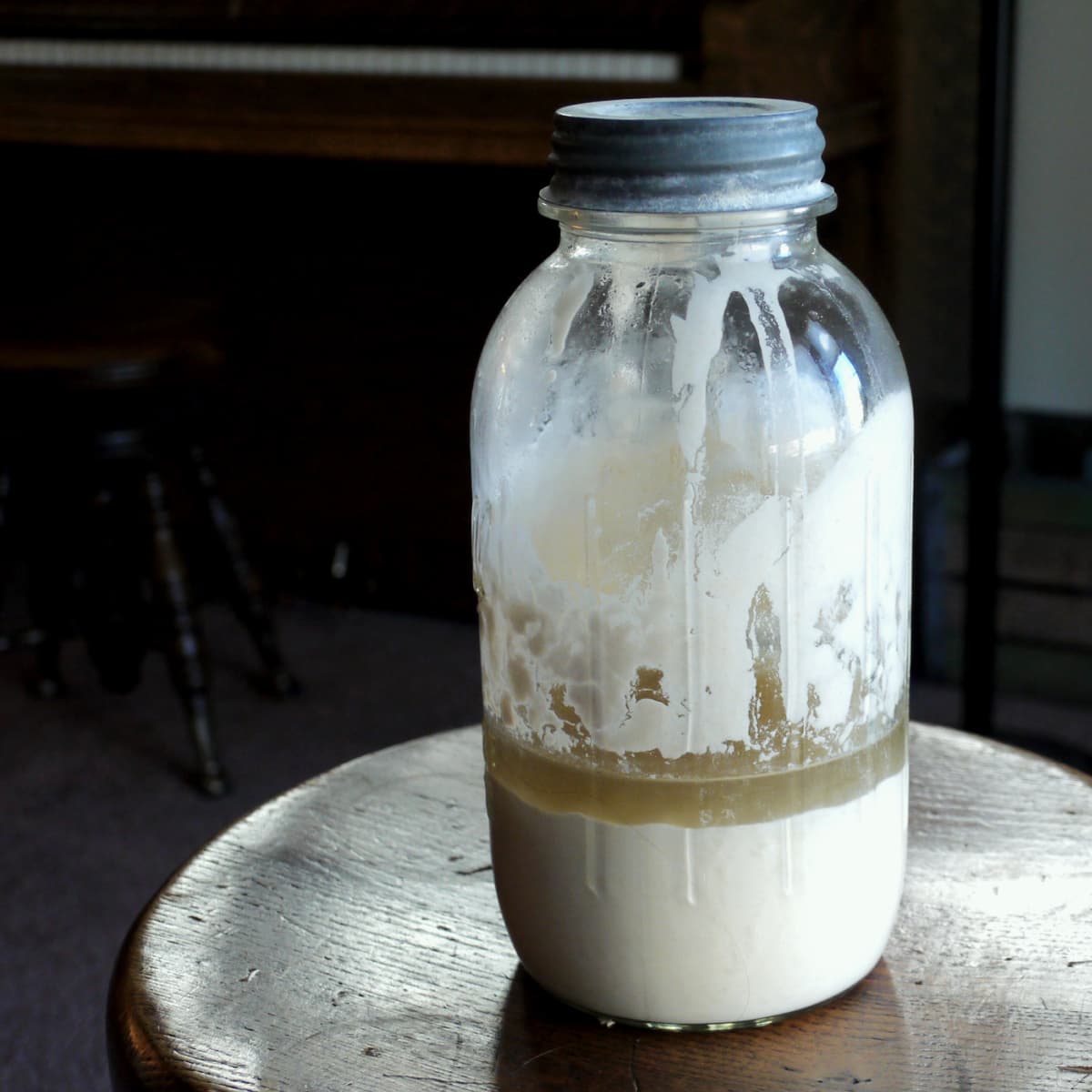
Jump to:
How to Maintain Sourdough Starter
Over the years, I’ve had an on again, off again relationship with my Sourdough Starter. Sometimes I treat it like the Queen at High Tea, sticking to a precise schedule and attending to its every bubbling need. Other times, I completely ignore it: I once forgot it in the back of the fridge for almost six months. Still, it persists.
My sourdough use waxes and wanes in bouts that can last weeks, or even months. In waxing cycles, when I am baking bread nearly every day, a loaf rarely hits the cooling rack before someone slices off an end. We have homemade bread for our sandwiches and for our soup. We take it in our lunches and feast on it warm with slathers of peanut butter and sprinkles of sugar.
But then I lose interest, and months can go by before I even give it a second thought again. Then Oh, what great consternation arises among certain citizens of our household! I get this a lot: "Mom, that jar of sourdough looks disgusting! If you aren't going to use it, then just throw it away!"
Never! I know good sourdough parents don't have this problem. They feed their starter regularly, and they bake a loaf every three days like clockwork.
This post isn't for them.
Sourdough Parenting 101
This post is for the rest of us. The negligent. The distracted. The throngs of home bakers who avoid sourdough altogether because they instinctively know that the waning times will come to them as well, and they just don't want to deal with the guilt.
Guess what? No one needs to feel guilty. Because a good Sourdough Starter will stay alive in the fridge with very little maintenance for extremely long periods of time, and can easily be activated when you want to use it. (OK, not really "right when" you want to use it: you need to plan about a day or two in advance.)
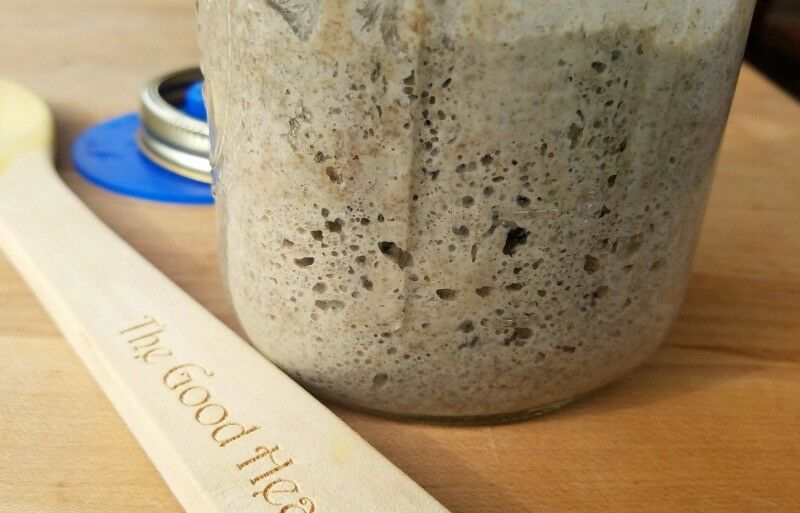
How to Feed Sourdough Starter
Sourdough starter can live forever – as long as you regularly give it a little attention. In other words, you need to clean their home occasionally and feed your sourdough starter regularly.
Sourdough starter is actually full of living colonies of yeast and lactic acid bacteria. These beneficial microbes consume the carbohydrates and proteins in the Starter. During this process, they ferment and convert those starches into CO2. It is this CO2 gas that provides leavening in your sourdough bread.
When these microbes run out of food, they get hungry and start to slow down. If you leave them alone too long, the whole colony will die (and take your neglected Sourdough Starter out with it).
(NOTE: I have yet to completely kill a Sourdough Starter; and believe me, I've tried.)
Healthy sourdough starter can be refrigerated for up to a week between feedings if you are not using it for other things. (Honestly, I often leave it FAR longer with no problems.) However, most sourdough experts recommend feeding Sourdough Starter at least twice a week for best results.
When you feed your starter, always use a wooden or non-reactive spoon to stir it. Never allow any kind of reactive metal to come in contact with your sourdough starter. (Stainless steel is fine.)
The amount you feed your sourdough starter depends on how much of it you have to start with. You want to approximately double your starter each time you feed it.
For example, if you have 8 ounces of Starter, you will feed it 4 ounces of water and 4 ounces of flour.
I keep a 100% Hydration Starter. A 100% hydration sourdough starter is a sourdough culture which is kept and fed with equal weights of water and flour. (If you don’t have a kitchen scale, that equates to about ⅔ to ¾ cup of water for every cup of flour.)
Always leave enough room in your Sourdough Jar for the Starter to triple in size!
Heavens, No! You can make all kinds of yummy things with extra sourdough starter! (Start with my mom's sourdough hotcakes or our delicious Cranberry Crumb Sourdough Coffee Cake recipe.)
If, however, you have more starter on hand than you anticipate using for baking, you will need to toss (or share!) a cup or more, and then double what remains. You always want to have at least 8 ounces of Starter after baking to keep the process going.
After you feed it, allow the starter rest in a dark, warm place (70°F) for 12 hours, and then place in the refrigerator if you will not be using it in the next 24 hours.

Stages of Healthy Sourdough Starter
When you want to bake with sourdough starter, you first need to determine if your recipe calls for Fed, Active, Ripe, or Unfed Starter. (For example, my Easy Sourdough Bread recipe calls for Unfed Starter)
- Fed Starter – Fed Starter is active, healthy starter that has been fed within about 2 hours. By hour 2, it will be producing little bubbles on the surface.
- Active Starter – Starter is Active about 5 hours after feeding. By hour 5, you should be able to watch large bubbles actively rising through the Starter and making their way to surface.
- Ripe Starter – Starter is considered Ripe about 8 hours after feeding. The volume has doubled, and the top is just beginning to show signs of sagging under its own weight.
- Unfed Starter – Unfed Starter is healthy, vigorous Starter that has not been fed for 12 hours or more. By hour 12, it collapsed after Ripening, and is ready to be fed again or put in the fridge until next time. (Note that this is NOT neglected Starter that hasn’t been fed in days.)
- Discard – Sourdough discard is the portion of your sourdough starter that you get rid of when you do a feeding. It should be healthy and vigorous, with some small bubbling activity.
If you aren’t up to making bread, you can always use up extra Starter (i.e., Discard) by making pancakes, waffles, etc.
Always reserve at least 8 ounces of Starter to feed and keep the process going.
How to Revive Neglected Sourdough Starter
So, you just found your forgotten jar of Sourdough Starter in the back of the fridge, sad and neglected under a little puddle of hooch. (Or a big black cloud of ick.) Don't worry - it happens to the best of us.
Before you can try to revive your Starter, you need to do some triage. Open your jar and look inside.
- A - If mold is aggressively growing, if it has a distinctly pink tinge, or if it smells rotten or putrid, toss it. There is no saving it. Then get a fresh, clean jar, and start making a brand new Sourdough Starter.
- B - If it looks gross but doesn't smell horrible, continue to Step 1.
- Drain off any hooch from your old Starter. (Hooch is the grey-black liquid that is probably sitting on top of your Starter. It's basically sourdough poop.)
- Using a stainless steel spoon, carefully spoon off the top layers of Starter. You want to try to completely remove the top layer and get down to the cleaner, dormant layer without contaminating it too much with the gross stuff on top.
- Determine if your Starter has totally gone bad, or if it is salvageable. (90% of the time, if it gets past the initial triage, you can save it.) Smell the stuff at the bottom of the jar. It should smell decidedly sour, but not rancid or spoiled. You know the difference. If it smells putrid, chuck it.
- If at least a tablespoon of your Starter is salvageable, put as much "good starter" from the old jar as you can into a fresh, clean jar.
- Stir in one half as much flour and water as you would normally feed a healthy Starter. For example, if you have a cup of salvageable starter, stir in 4 ounces of water and 4 ounces of flour. (I always use a kitchen scale when I feed my Starter.) If you have only a tablespoon of starter, it's going to take you a little longer to build it back up, but you can do it. (Wilbur, my 100-some year old starter, was revived from less than a half teaspoon of dried flakes!)
- Allow fed Starter to sit at room temperature again for 8 hours.
- Repeat Steps 5 and 6 one or more times, until your Starter is bubbly, percolating and ready to use.
The total "revival" process usually takes 24-48 hours hours. After that, you will should have an active, bubbly Starter that you can either put it back in the fridge and ignore it again until next time. Or, you can continue to wake it up by feeding it every 8 to 12 hours for a day and get ready to bake!
[Read more about how to revive dried sourdough starter here.]
Once your Starter is vigorous and active, you can go back to feeding it once or twice a week. After every feeding, allow it to sit out for 12 hours before putting it back in the fridge.
Sourdough Recipes
A final note for all you Artisan Sourdough Bakers out there who feed your starter regularly: I know you've been cringing your way through this entire post! Please be kind in your comments. We all know that this is not the optimal way to take care of sourdough starter. But for those of us who are on-again, off-again in our baking and find ourselves with neglected sourdough starter, this protocol is better than a kick in the head, as my Dad used to say.
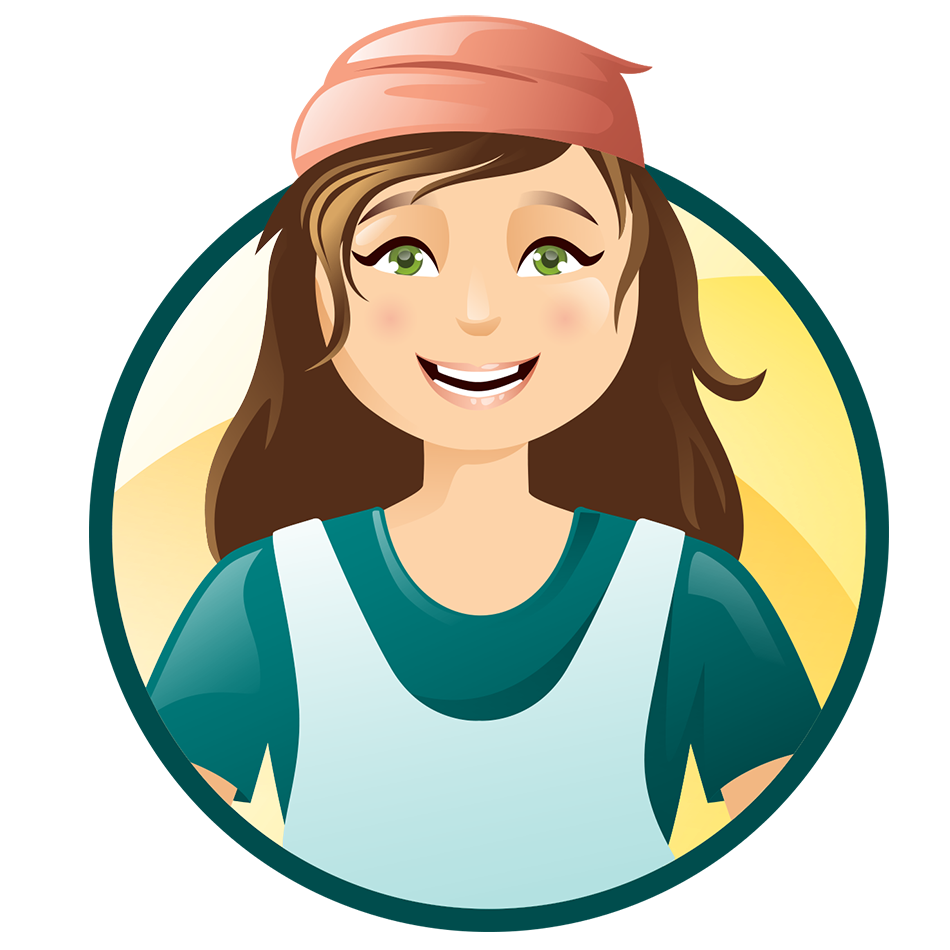
Want More Free Recipes?
Subscribe to our newsletter to get family-friendly recipes and cozy living ideas in your inbox each week!
Find us on Instagram, Pinterest, and Facebook, too.

Thank you for visiting the Good Hearted Woman. Remember to bookmark this site, and come back soon!


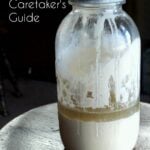
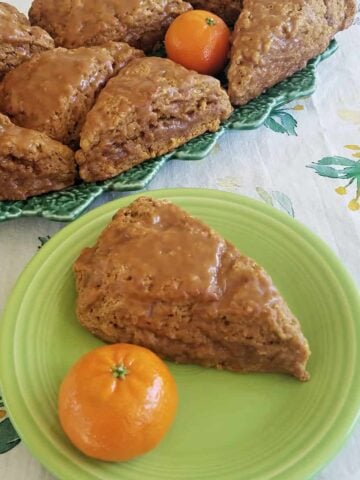

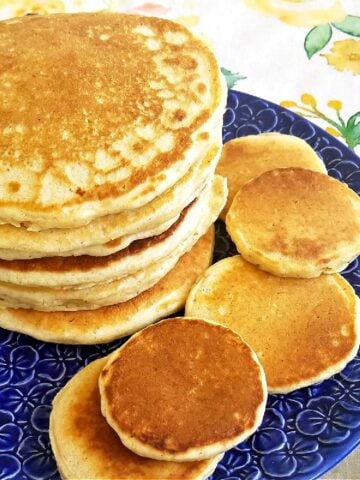
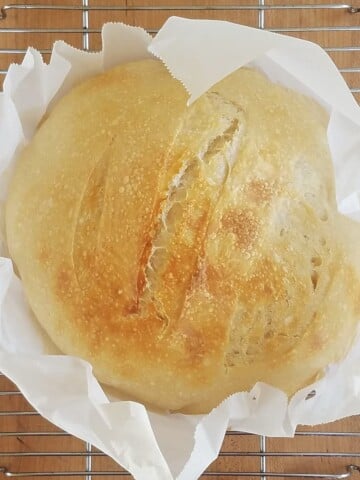

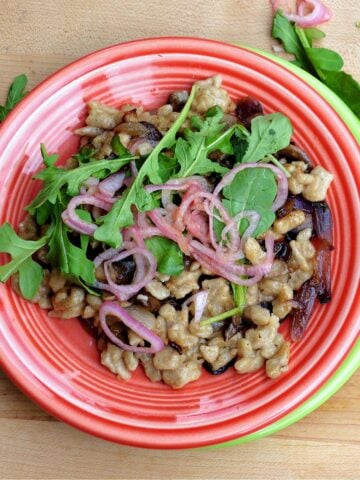

Monique says
I’m pretty confused about the discard - how you actually do it and how much? I am just starting my very first starter I did day 2 this afternoon of your rye starter once I get to day 5 - then what? I do want to convert this to white flour but I can’t find how to proceed after the first 5 days.
Renée B. says
Sourdough can be confusing at first, but (IMHO) much of that comes from overcomplicating the process. In simple terms, "discard" refers to the portion of your starter that you remove when you feed it. This discarded portion can be used in a variety of discard recipes, like scones, pancakes, crackers, etc.
Once your rye starter is well-established, transitioning it to a white flour starter is easy. All you have to do is start feeding it with all-purpose (AP) flour instead of rye, and over time, the starter will adapt to the new flour.
Elza Albertyn says
Thank you so much for clearing u the mystery of The Sourdough Startet! My first attempt today - wish me luck ! Elza from Darling, South Africa🦋
Renée B. says
Good luck to you, Elza!
Carol Hampton says
I’m not sure I completely understand. I have starter in the fridge. When I remove some starter and feed it and use that for my recipe do I also feed my remaining starter?
Renée B. says
Usually when you make a sourdough recipe, it will call for unfed starter (i.e. sourdough discard), like sourdough pancakes, you use unfed (hungry) starter for the recipe, and then feed the remaining starter to keep it active and healthy.
Sheree Hyde says
I just found your website and I hope it inspires me to try again. I just tossed my latest attemp at starter after buying 3 different types of flour to make it go. On day 3 I woke up to find a starter that climbed out of the jar and made a total mess in my microwave. Needless to say, I was delighted as it had worked. After that, nothing, no matter how hard I tried. It just lay there in its jar, daring me to pitch it, which I did after day fourteen, nothing but now a foul smelling mess. Help me!
Renée B. says
That sounds so frustrating! I always start a new sourdough starter using rye flour exclusively. Once a healthy Starter has been established, you can always transition it to all-purpose flour. The trick is to keep it in a warmish place where the temperature doesn't vary too much, and you must divide it and feed it regularly. In the summer months, particularly if you are in a humid climate, you will want to keep it refrigerated except when you plan to use it for baking. (We suggest feeding it for 3-5 days on the counter before using it if you like a sweeter-tasting bread.) And yeah, two weeks is way too long for it to just "sit there."
Let me know if you have any specific questions - we're happy to help!
Liz says
Renee, I absolutely love your post! I am just like you! I treat my starter like royalty and then I ignore and neglect it to the point of near death at times. I think the longest I have gone without feeding my starter is 2 months and I was still able to revive it! One time I was trying to quick activate my starter and I put the oven on low, turned it off and put my starter in. Well my oven is no proofing drawer and I baked partially baked the edges of my starter. At the time I was still feeding two starters-the one I made from scratch and the one with a lineage of over 100 years given to me by my sourdough mentor. I felt devastated, but all was not lost because I was able to scrape about a gram from each jar. I combined them and fed the new mixture 2 to 1 twice; resulting in a strong and happy starter. Course I had to rename it. My reincarnated starter is Doughy Tribiani! Anyways, following you now because you are a down to earth baker that I can totally relate to and your voice provides a much needed sensible approach to the newbies to artisan baking <3
Renée B. says
Thank you so much for the kind words: it means so much to know you can relate. In this Insta-TikTok world, keeping things real isn't always encouraged, and I genuinely appreciate your support.
I'm intrigued with your 100-year starter. Do you have the lineage on it? (It's a fun little bit of family trivia if you do.) It is amazing how those old starters can survive the worst of conditions.
P.S. I *love* "Doughy Tribiani"!
Rosemary Lewis says
How do I make a starter?
Renée B. says
Visit How to Make Rye Sourdough Starter for step-by-step instructions.
Penny says
Why do you need to let the starter sit out after you feed it before putting it in the fridge? I usually feed it and put it back in the fridge right away so it eats slower and when i take it out, it doubles on its own
Renée says
I've just always done this so it is ready to go the next day. However, you can definitely put it right back into the fridge after feeding it.
Ann Cranford says
When I put my starter in the fridge can I put the jar lid on tightly
Renée says
Yes, you can cover it tightly when you put it in the fridge. It's best to keep it in the back, coldest part of your fridge if you do.
Marie says
Wait, what if I accidentally mixed the starter all together (poop and all) and fed it before googling... should it eventually come back to life? Will it just take longer?
Renée says
It will probably be fine. In fact, some old sourdoughs adamantly insist that the hooch should never be drained. (I am not one of them.)
There is a distinct difference between the smell of sourdough with a little hooch floating on the top and sourdough gone bad. You can usually see the difference, and if not, you can definitely smell it. Good starter will have a fresh, yeasty, occasionally sharp smell. If it has just gone too long without feeding, hooch will start to float on top and it can smell like alcohol. When a starter has gone too far (or almost), it will smell funky and spoiled, and possibly like acetone.
Allison says
I once read to stir the hooch into it, so that's what I've always done! So far, so good!
Renée B. says
Do what works for you!
Hooch is harmless, but best practices for sourdough advise pouring it off off prior to feeding the starter. If a hooch is regularly forming on your starter, it means it is starving for food. In this case, consider feeding the starter more frequently, or moving it to a cooler spot.
Alyssa says
I talk about how I neglect and abuse Agnes all the time. That’s my baking style as well—baked goods non stop to months without feeding Agnes—poor lady.
You piqued my interest at Wilbur. Who did you get 100-something year old Wilbur from??
Renée says
I got Wilbur from "Friends of Carl." They will mail you Carl Griffith’s 1847 Oregon Trail Sourdough Starter in dried form for the cost of a self addressed stamped envelope. For details, visit Friends of Carl.
Ashley says
You spoke to my heart on this one! I love my sourdough starter, but have definitely "forgotten" it in the back of the fridge for a good 2 weeks. Thank you for sharing these wonderful tips and tricks!
Renée says
LOL! If you're anything like me, that "two weeks" is a pretty murky time guestimate at best!
Mindy says
Hooch can be stirred back into the starter. I've tried it and it didn't kill anyone.. in fact it made wonderful sour tasting bread!! It's fine as long as it still smells ok and no orange or pink or obvious mold.
Meg says
This is a fun post, thanks. A friend gave me sourdough starter and I've finally learned to make sourdough bread. I keep it in a fridge we have in the basement and I *only* feed it right before I'm going to make new loaves of bread. And it always rises! I never feed and discard, I only feed and then bake. Now THAT is my kind of starter. 🙂
Lisa says
On the days i am to discard. Can i add it to a jar and feed to make more jars of starter? I have 7 friends that would like starter. If so are they on the “same” day as the first jar feeding schedule i assume?
Renée says
Exactly right!
Tammy Weinzatl says
LOVED this post! Glad there’s someone else that is a bit neglectful of what I call “feeding the pet”. I’ve found that sourdough starter is very forgiving. It is so fun and interesting to keep the starter and all the deliciousness that one can make with it. Thanks for your recipes!
Renée ♥ says
Thanks for stopping by, Tammy. You are definitely not alone! ?
Create/Enjoy says
Wow! Very cool you're making your own!! I've never tried, but guess it's not too hard! No bread for me now, but we have made kombucha and raw sauerkraut at home... fermenting adventures!
Melinda says
Thank you so much for this post! I've tried sourdough starter in the past, but without much luck. With your tips, I;m going to give it another try!
Bill Volckening says
That's one thing I haven't tried to make. I read the recipes in the past and thought, "that's a lot of work!" but I'm sure it's totally worth it!
Sharon (Nut Free Wok) says
My kids love home made bread and this is an amazing sourdough primer, thanks so much for sharing all your tips and suggestions! Can't wait to try!
Rachel says
hahaha this post really made me laugh. I agree with Marilynn, your point of view is really great. Keep it up!
Bea says
Love it!!! I go through spurts baking up a storm for weeks, and then months of nothing. Yes, not even a cookie…now I have to admit that I have stayed away from Sourdough for as long as I could and think that now finally is the time to get into it. Heck, I am happy to hear that there is little maintenance involved - first strip I guess is to get some sourdough starter. Where is good place?
Oh, and Happy New Year to you and yours.
nourished roots says
I have wanted to try my hand at sourdough for a long time. Any suggestions on where to get a mother or do you just start your own- I am a total virgin in this process!
Renée ♥ says
For the price of a couple of stamps, you can get Starter from Oregon Trail Sourdough.
Marlynn [UrbanBlissLife] says
LOL - I love your take on food, Renee. I'm a firm believer in there are no hard and fast rules, just do what works for you, and if this works that is AWESOME! I've never wanted to make my own sourdough because it's so time consuming, but I would follow your method in a heartbeat! Thank you!!
Marye says
Sourdough poop! BAHAHAHAAAA... I will never look at that stuff the same way again... LOL!
Susan@LunaCafe says
LOL! You had me long before '"sourdough poop" but that sealed the deal. I always end up tossing the neglected starter and beginning again. It looks so disgusting. Great to know that it isn't necessary. 🙂